
Are you a construction company looking to improve your online visibility and attract more leads? Look no further, because in this article we’ll be discussing how to do SEO for construction and the best practices.
SEO can help construction companies increase their online visibility and reach a wider audience.
In this article, I’ll be providing you with tips and strategies for keyword research, backlink building, on-page optimization, local SEO, and more specifically tailored for construction companies.
1. Implement Technical Best Practices
The first and essential part of your SEO for Construction strategy that you must implement to rank high in search, bring potential customers to your website, and generally have a functioning website is to implement proper Technical SEO.
Properly setting up a website with a solid Technical SEO foundation ensures your website can easily be discovered by your B2C or B2B target audience for your related search terms.
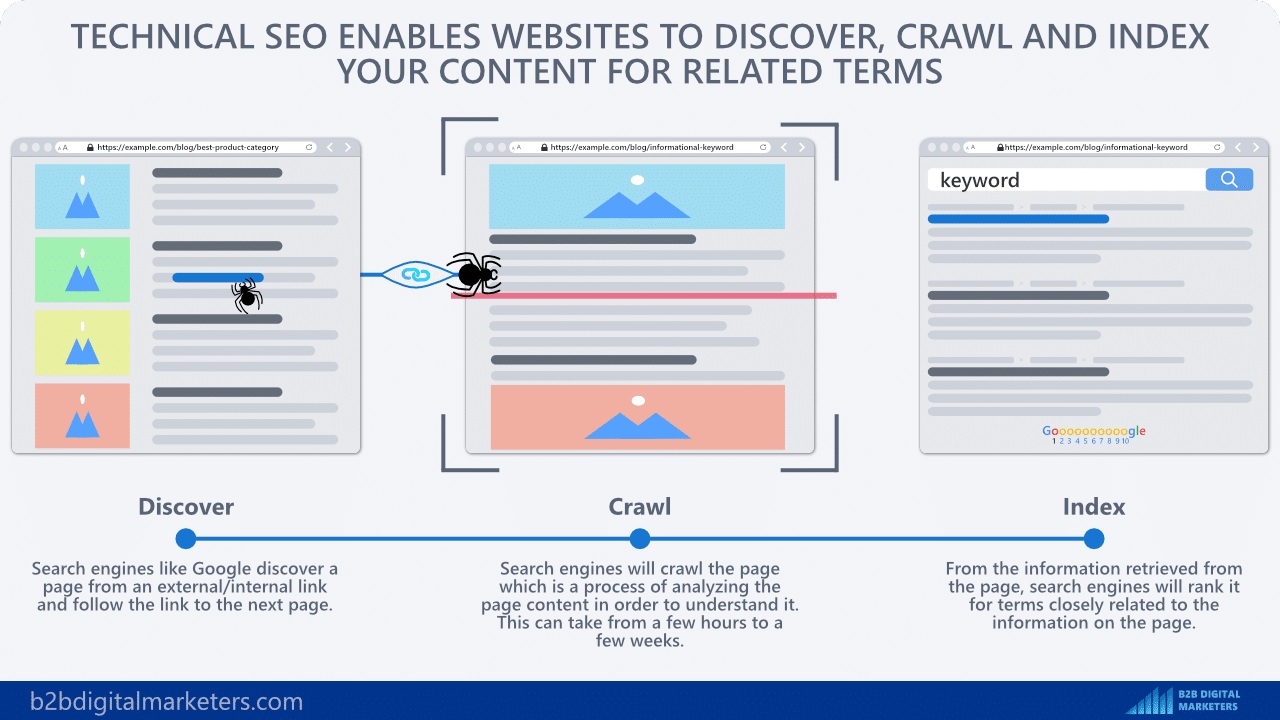
It also helps you meet the Google Core Web Vital algorithm, which focuses on website user experience and loading speed.
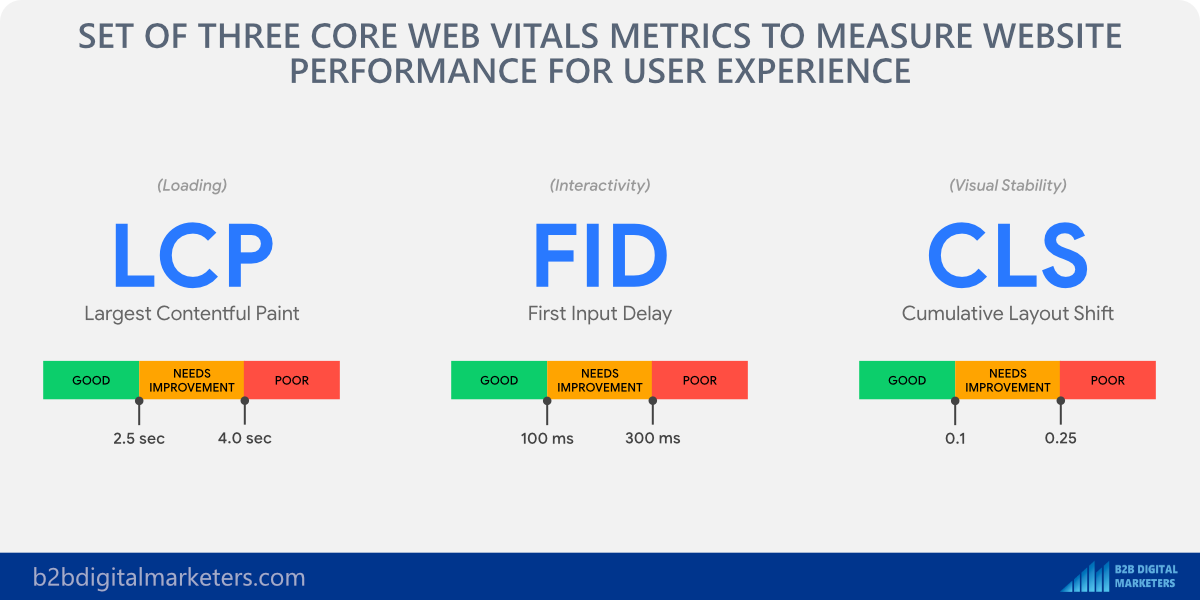
And of course, technical SEO can get very technical and if you are not a technical guy, then this can get intimidating. But luckily the most important part of technical SEO is not even handled by you if you don’t want to.
So here I am going to share with you the technical SEO best practices that require 0 technical or SEO skills and can be implemented by an absolute beginner and still meet Google algorithm requirements:
- Use Fast Hosting: Hostings are having a big impact on your page speed and your ranking. The cheaper you go, the more likely your website will not perform well, and I am not even talking about the chance of being hosted on the same IP address as the same dodgy websites. Instead, you should invest in good hosting, I recommend Hostinger, SiteGround, or WPX. Try to get a dedicated IP address for yourself. Or check out HostGator alternatives.
- Ensure You Have SSL: SSL certificate protects your website and security is a top priority for Google, so it’s a part of their algorithm. Luckily, this is implemented by Hosting, just make sure you have it.
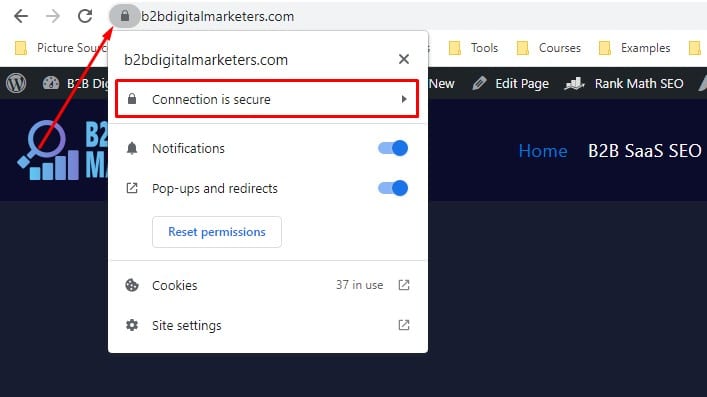
- Implement CMS System: CMS systems help you to handle most of the technical parts of having a website and even allow you to design a website without any coding or technical knowledge. The best CMS systems for me are WordPress (free), Webflow, or HubSpot CMS. These are paid, but fast.
- Implement a Fast Theme: Theme is another important part of your technical SEO, as they handle another big part of your technical SEO, specifically, having a beautiful website, that loads fast. For WordPress, the best fast-loading and yet excellent design themes are Elementor, Divi, or Avada. They also have templates that help you to get started very fasts.

- Implement Caching Plugin: These little apps for your website ensure your website is properly set from a technical stand of view. They help you minimize the size of your website and ensure fast loading and a pleasant user experience. The best WordPress caching plugin is WP Rocket, and the free ones are WP Super Cache, WP-Optimize, or LiteSpeed Cache.
- Implement Image Plugin: These image optimization tools will help you improve the quality of your images by compressing and properly sizing them. This is important because it ensures that your images are displayed correctly on different screen sizes. Some of the best image plugins for WordPress include Smush, Optimus, and ShortPixel.
- Implement SEO Plugin: These apps will help you with implementing some of the best practices for SEO as well as simplifying a lot of your work and are used even by the best SEOs. The best SEO plugins are Rank Math, Yoast, or All In One SEO.
- Check Website Responsiveness: Whenever you are designing your website, it’s also important that your website is properly sized for mobile and tablet screen size. Most modern WordPress plugins allow you to rearrange your design for different types of devices.
- Add Structured Markup to Your Website: These are snippets of codes used by search engines to get important information about your website in order to show you in rich feature results. For SEO construction the most important is a local business snippet. Luckily SEO plugins can help you with that, you just need to provide information to them. Check out Google Data Markup to find relevant for you.
- Remove WordPress Tags from Indexing: WordPress tags can easily create hundreds of pages with no meaning or importance for SEO and if you let Google crawl them, they might not have time on your important pages. Therefore, you want to use your SEO plugin to “noindex” them all.
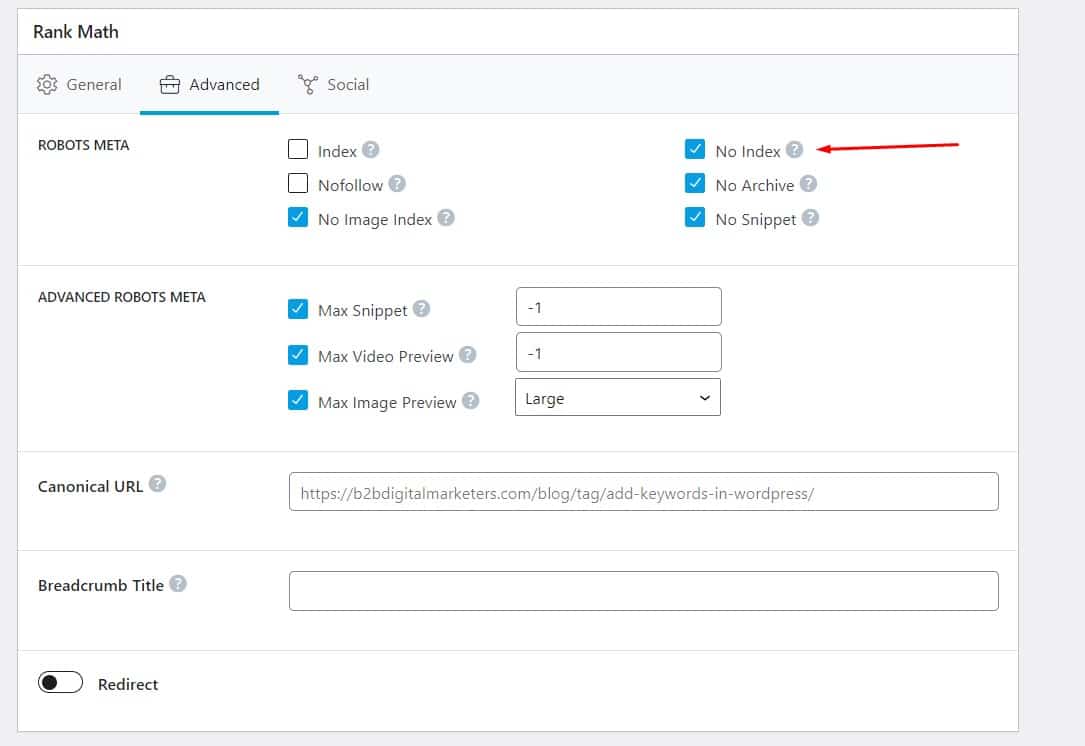
With that, these technical SEO best practices will help your construction company to ensure your website is not being penalized or at a disadvantage in ranking, so you can maximize your SEO results.
You also need to register your website at these important free SEO platforms to track your website performance:
- Google Search Console: This is a free service offered by Google that allows you to monitor and maintain your website’s presence in Google Search results and helps Google to index your pages.
- Google Analytics: This is a free web analytics service that helps you track and understand your website traffic.
- Bing Webmaster Tools: This is a free service offered by Microsoft’s Bing search engine that helps you monitor and maintain your website’s presence in Bing search results and also helps Bing to index your pages.
- Microsoft Clarity: This is a free analytics tool that helps you understand and improve the user experience on your website. It provides insights into how visitors interact with your website, including what they click on and how long they stay.
By registering your website with these platforms, you can track the performance of your website and make necessary improvements to improve its visibility and user experience as well as provide information to search engines about your website to improve your website crawling and indexing.
2. Implement On-Page SEO Best Practices
Another important part of SEO strategy for construction is to implement proper on-page SEO on every of your web page.
On-Page SEO helps search engines to better understand your content to help you better rank it for related search terms that will help you attract potential customers to your website.
It also helps users easily find the information on your website they are looking for.
With that, here are the best practices for on-page SEO for SEO construction:

- Implement SEO-Friendly Headlines: Regardless it is for your blog posts, product, category, or service pages you need to implement SEO-friendly headlines by including your primary keywords and making them relevant and interesting to people to keep scrolling. Definitely, you need some SEO copywriting skills for this.
- Implement SEO URLs: Every time you create a new page, you need to have a URL. There you always and only want to add your primary keyword and nothing else. For example, if one of your services is “construction estimates” then your URL should look like this “services/construction-estimates/” more on this later.

- Focus on Keyword Placement: Google said, that if you want to tell them something make it as prominent as possible. Search engines are still searching for keywords on pages to correctly index the content, so you should include your primary keywords in the introduction, headings, and images, throughout the content, titles, and meta description. (Learn more: Where and How to Add Keywords in WordPress)

- Implement SEO Title Tags: It’s important to create SEO-friendly title tags as Google is using them to better understand your content and their algorithm. Also, good titles get users to click on your search result. I recommend always adding your primary keyword, keeping it short, and if possible, adding numbers.
- Implement SEO Meta Description: Similarly, to titles, they appear in search results and search engines are using them to better understand your content. However, in most cases, Google rewrites meta descriptions for you to make them more relevant for users and increase your CTR. Yet I still recommend you add your primary keyword and create an interesting hook to get users to click on your results.

- Create SEO-Friendly Images: Use descriptive and relevant file names for images. Instead of using generic file names like “image1.jpg,” use descriptive file names that include your keywords related to the image, such as “construction-site-safety-gear.jpg.

- Add LSI or Secondary Keywords: Including relevant keywords to your content can increase your web page visibility, increase organic traffic potential, help search engines better understand your content, and provide more value for your users. Therefore you should always create a list of LSI keywords and secondary keywords for every of your page.
By following the on-page SEO best practices you will improve your page indexing and ranking for more related keywords and potentially increase your website traffic.
On-page SEO is a white-hat SEO practice that legally allows you to navigate search engines to improve your ranking. Therefore, you should always ensure you implement the best practices for on-page SEO for your construction website.
3. Implement Logical SEO Website Architecture
Another important best practice for SEO construction is to organize your content into logical SEO website architecture in order to improve your crawlability, ranking, and user experience.
SEO-friendly website architecture means organizing your content into logical categories and interlinking them together to create strong semantics signals between each other.
For example, your services pages should be under the service category, your products under the product category, and company-related articles under the company category.
You also want to make sure you have implemented SEO-friendly URLs as I told you, so have only primary keywords in your URL.

You also want to minimize the page depth, meaning ideally you want all your pages to be in page depth no greater than 3.
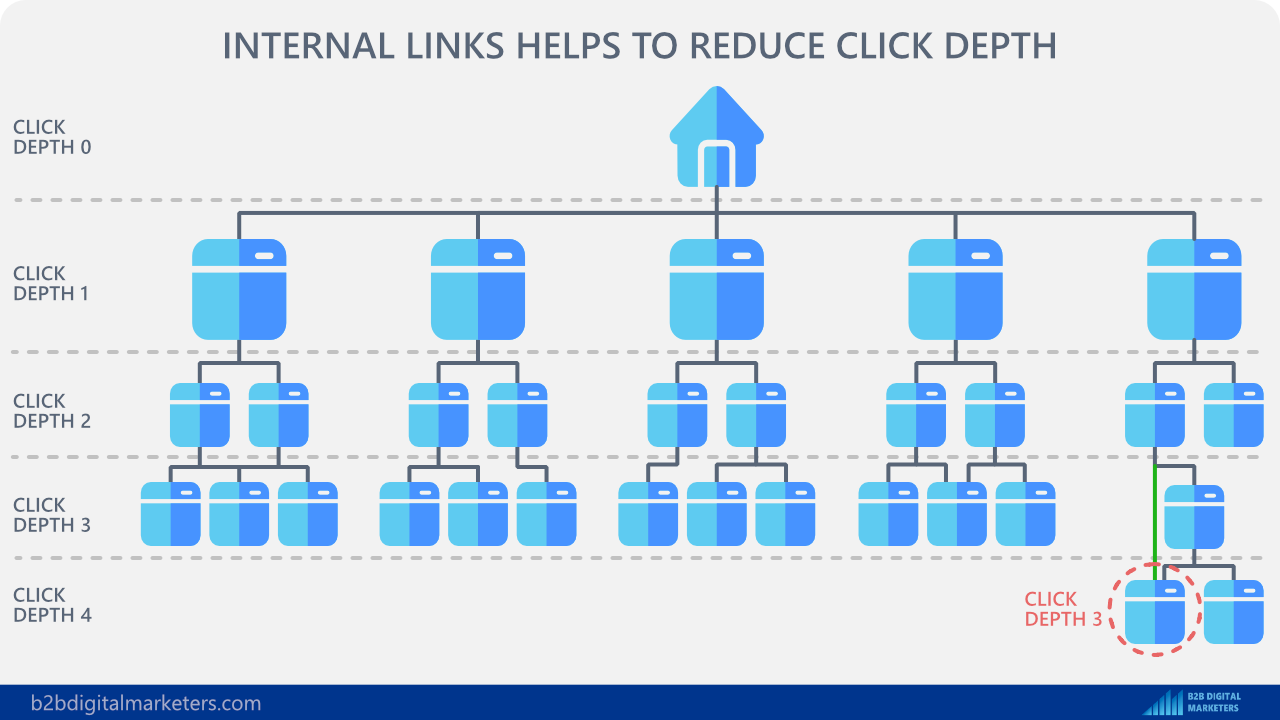
To find out your page depth, you can use SE Ranking Website Audit tools. It will show you exactly what pages are in what page depth.

And based on that, you will need to create internal links to those pages with a page depth higher than 3 from pages with a page depth smaller than 3.
Then of course you want to also eliminate any orphan pages or orphan silos for those pages that are meant to be driving organic traffic. Unless those pages are only for PPC purposes, and you want them to be not accessible.

Now, when it comes to blog posts, you should categorize them under your blog category, which eliminates the option of categorizing your content in URL.

So, instead of that you can use internal links as they reinforce the website architecture and can substitute the organization of your content in your URL.
To do that, you will need to create categories as content hubs for your content and then interlink the blog posts under the same category or subcategory with each other.
For example, let’s say one of my categories is SEO, so I would link to that category from my blog page. Then within the SEO category, I would have relevant subcategories such as Link Building, Keyword Research, Local SEO, etc. And under the subcategories, I would have links to all the related articles as well as to the subcategory page itself with links to all the related articles.

And like this, you will want to categorize your content, in order to boost your semantic SEO and send a strong signal to Google about what’s your page about.
4. Create Topic Clusters for Important Categories
The next strategy for SEO construction is to create relevant topic clusters for your important categories and money keywords.
Creating topic clusters will further help you establish topical relevancy and connect your relevant pages and most importantly blog posts with each other.
Topic clusters are the next step of creating a logical website and content architecture as it allows you to logically connect relevant pages between each other such as relevant blog posts with category, service, and or product pages.

With that, to create topic clusters, you will need a seed keyword. To create a seed keyword, you just take one of your main services or products such as “commercial construction services” or “bulldozer” and take only the main part from the keyword to create a general term for that keyword.
In this example, it would be “construction” or “bulldozer”. The goal is to create a general term related to your industry and then you can create a topic cluster.
For example, let’s say I want to create the topic cluster for the keyword “construction”, so I would pop it into SE Ranking Keyword Research Tools, select my target country and click on “Analyze”.

Here I will get a high-level overview of the analyzed domain such as the keyword difficulty, search volume, CPC, Global Volume, and more. So now, I will go to the Keyword Suggestion report.

And here I will want to pick all the keywords with the term “construction” in it such as “construction equipments”, “commercial construction”, “residential construction”, “construction loans”, “construction management”, “construction safety”, etc. and started creating appropriate content for these keywords.

And then started to interconnect all the content with internal links between each other to create strong topical relevancy, increase semantic relevancy, categorize the content and further develop my website architecture.
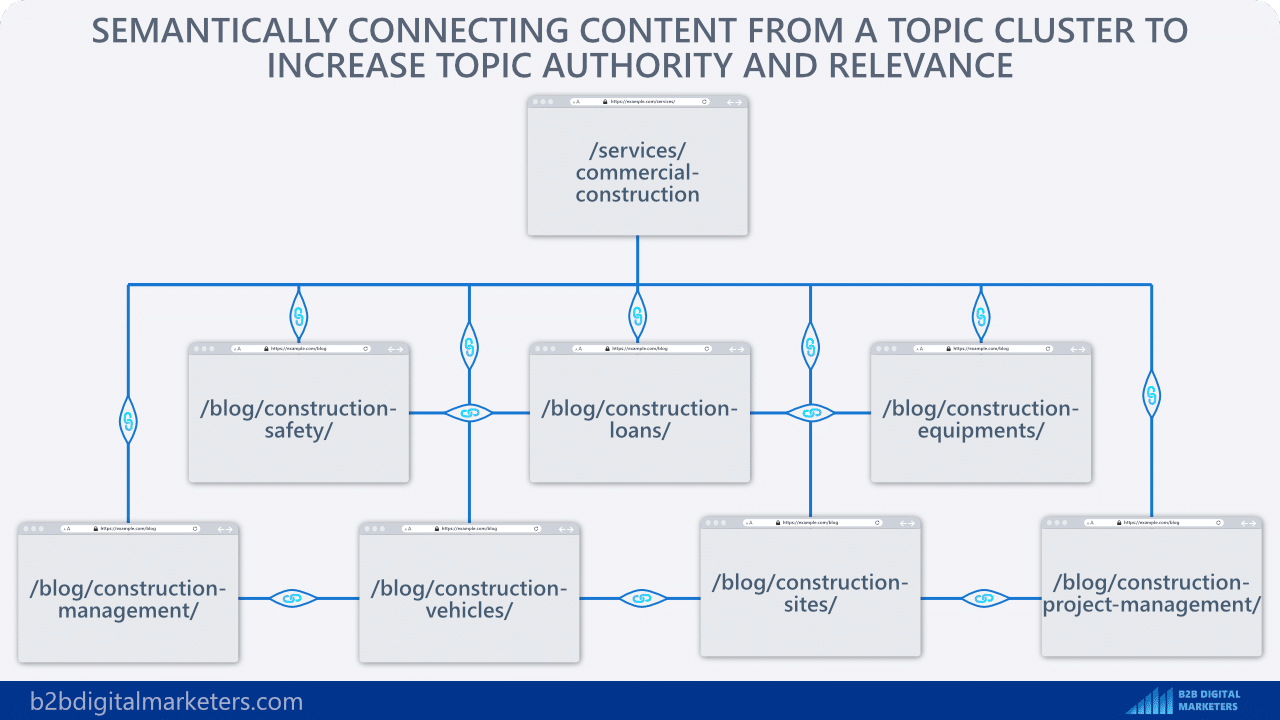
So, like this, you can gain topical authority and rank for most of your related keywords in the top positions in SERPs.
5. Implement Internal Linking Best Practices
As you could see from the examples above, internal links are extremely important and the reasons for that are that Google is using internal links to crawl your website to discover your new pages, which increases the speed of indexing them.

And Google also uses internal links to get better context about the pages, as they are looking at the anchor text of the internal links.
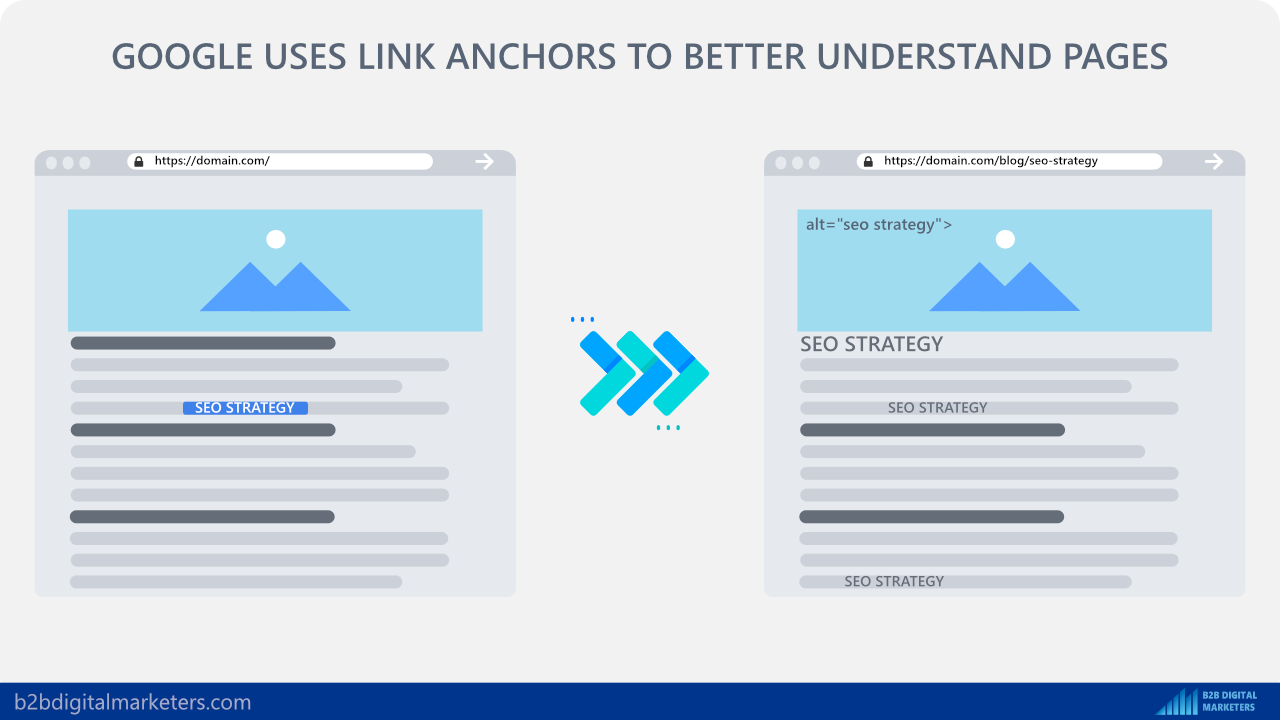
And lastly, Google also assesses the importance of the page by looking at the number of internal links coming to the page.

For that, internal links are extremely important, and here are some of the best practices that you should always implement:
- Create exact anchor text internal links: For example, one of my pages is targeting the primary keyword “seo checklist”, so I created internal links on those pages that mentioned this keyword. Or sometimes even rewrite the text to include the keyword. This is how you will want to connect your topic clusters, have mentioned the relevant keywords on the pages.

- Don’t use the Same Anchor Text for Two Different Pages: Never link to two different pages with the same anchor text. It only confuses Google, and you might end up with keyword cannibalization.
- Link to Important Pages: Make sure you link to your important pages, to improve their ranking. Especially to your money pages, more on this in SEO lead generation.
- Only Have Internal DoFollow Internal Links: As a rule of thumb, don’t have any internal links with a nofollow tag in order to improve the ranking for all your pages.
With that, to find internal links opportunities I am using this Google site operator (site:example.com keyword). For example, I have created a page targeting the keyword “seo audit” and to find internal linking opportunities, I use the following Google Site Operator. (site:b2bdigitalmarketers.com “seo audit”)
And this gives me results of all the pages on my website where I have used the keyword “seo audit”.
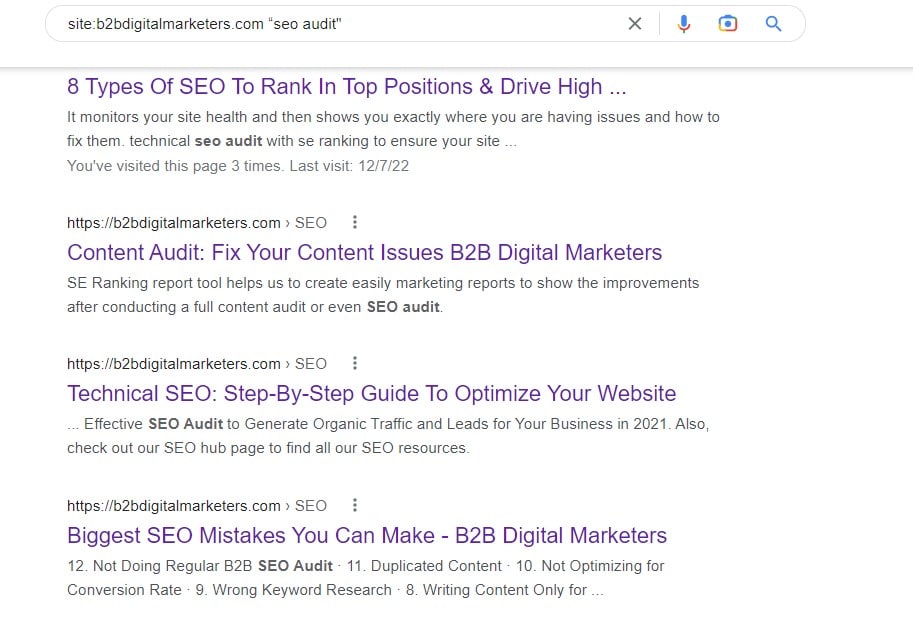
I also use Link Whisper to help me suggest any relevant internal links I could link to from my page, but be careful with it, as it is not so accurate.

6. Find SEO Keywords for Construction Companies
Finding SEO keywords is an important skill for SEO to succeed to find the most relevant keywords for your products or services in order to attract potential customers to your website, increase your online visibility, and become the thought leader in your industry.
And there are many ways to do keyword research (or b2b keyword research) to find keywords for your construction business such as body keywords or long-tail keywords and I have already shown you using seed keywords to find related keyword ideas.
So here I am going to share with you three more keyword research techniques you can use to find SEO construction keywords:
Technique #1: Do SEO Competitor Analysis
Your competitors can be the greatest source of ideas in terms of finding keywords related to your niche, that’s why you should do regular SEO competitor analysis or Keyword Gap Analysis.
Here is a quick crash course:
First, find your close competitors. You might already have some on your mind but let me show you how you can find hundreds of close competitors.
So, take your domain and pop it into SE Ranking Competitive Research tool, select your target location and click on “Analyze”.
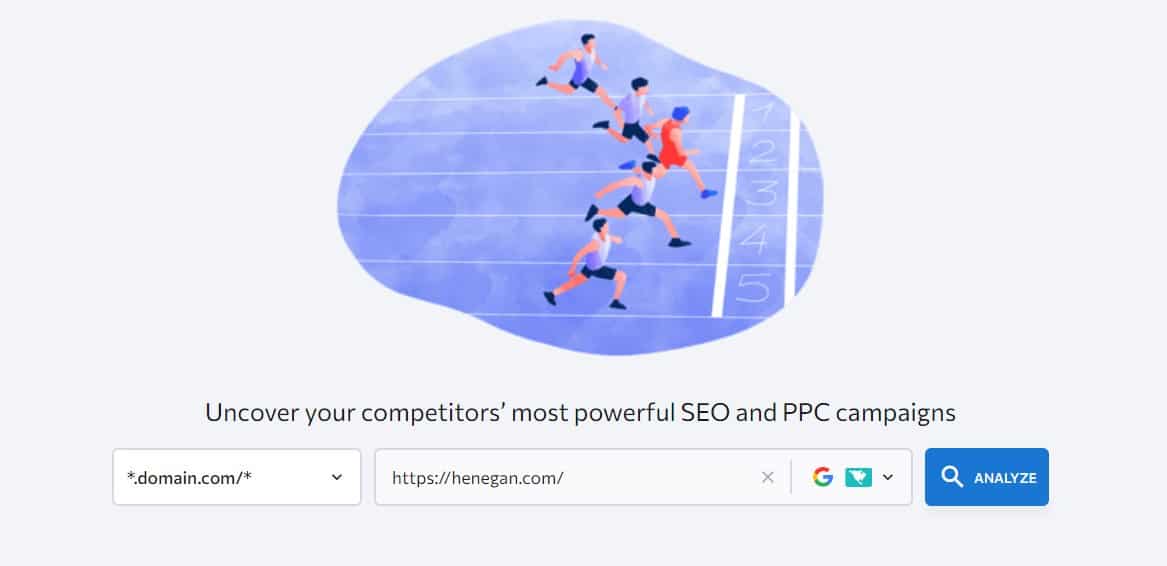
Here you will get a high-level overview of your analyzed domain such as the domain trust, estimated organic traffic, organic keywords, backlink profile, and more. So now, I go to the “Competitors” report in the “Organic Traffic Research” tab.

And here, you will have hundreds of close competitors based on your ranking keywords. So now I recommend you find similar domain trust websites to yours with more ranking keywords.
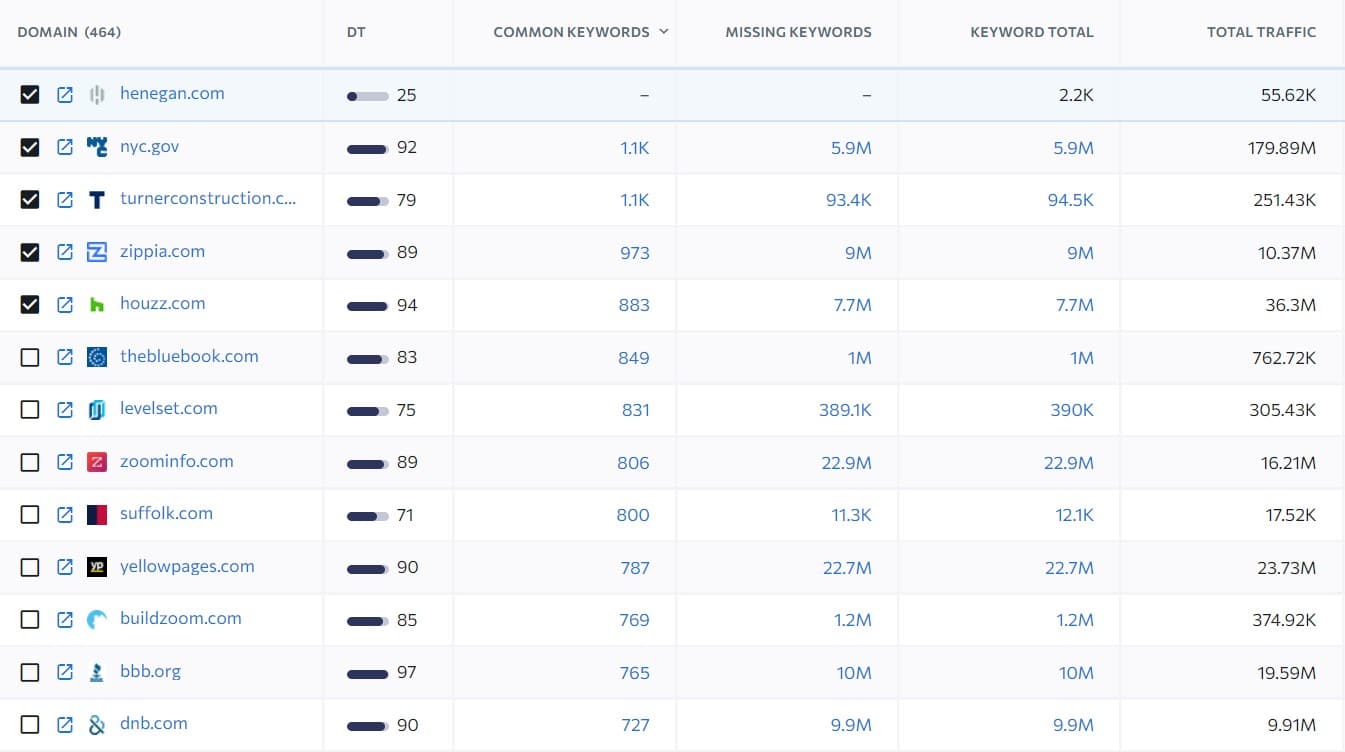
Once you have it, you will then use the Competitor Research Tool to analyze their website and go to the “Keywords” report.

And here you will need to go through the keyword list and find any relevant keywords to your business.

Technique #2: Check Your Industry Wikipedia Pages
Simply find any related Wikipedia pages to your industry, service, or product and start picking the keywords.
For example, the Construction Wikipedia page has plenty of keywords. In the beginning, you can find related keywords such as “planning”, “financing”, and “design” or “demolition”, decommissioning” etc.

All these keywords can be turned into SEO keywords by adding relevant terms to them such as “construction planning”, “construction financing”, or “construction design”, etc.
And when I look at the Table of Contents, I can find many more related keywords such as “construction processes”, “building construction”, “non residential construction”, “infrastructure construction”, etc.

And if I keep browsing through the content, I can find many more ideas such as “construction law” and more.

So, browsing through the Wikipedia page can be a great source of keyword ideas for your construction website.
Technique #3: Check Your Google Search Console
And the last technique I want to share with you is to check your Google Search Console. But this is only if you have already published a fair amount of content on your website.

Because your pages can rank for hundreds of relevant keywords, some of which can be a great idea for another piece of content.
Because if you see that you are already ranking for a particular keyword, it means that your website is appearing in the search results for that keyword. This is a good sign because it means that your website is relevant to that keyword and is being recognized by Google as such.
However, if you are only ranking for that keyword because of a general reference within your content this can be a great opportunity to improve your ranking by targeting the keyword with a dedicated piece of content.
And by doing this, you can signal to Google that your website is particularly relevant and useful for that keyword, which can help you rank higher in the search results for that keyword.
This is one of the best keyword research methods to find easy-to-rank keywords.
With that, there are many different ways to find your SEO keywords and if you are interested to learn more, check out my keyword research articles:
7. Invest in Link Building
The next important part of your SEO construction strategy is to invest in link building.
Link building helps you to get backlinks and they’re considered a “vote of confidence” that suggests that other websites recognize the relevance and quality of your website.
And backlinks are one of the most important Google Ranking Factors according to Backlinko research.
Therefore, investing in building high-quality backlinks is one of the best ways to grow your website’s organic traffic, especially because few do that due to it being relatively expensive or hard to do.
With that being said, here is a list of the best link building strategies to build backlinks for your construction website:
- Guest posting: just make sure the sites are legit and talking about your topics
- SEO Press release: this can be a very powerful way to start ranking in top results.
- Competitor Backlink Analysis: Analyze your competitors to find backlink opportunities for your website.
- Resource link building: This might be one of the best ways to get going.
- Niche edits: While good, only at a very slow pace can be done.
- Link Insertion: Very easy, but expensive and only a few can be built.
- HARO link building: This can be your best friend, especially if you are the doctor answering it.
- Podcast interview: Probably the easiest yet very effective way.
I also recommend you ensure you built backlinks on sites with minimum organic traffic of 500, preferably 1,000 according to your SEO tool.

And build backlinks on websites with similar domain trust to yours, instead of shooting for the highest authority websites to maximize your blogger outreach results.
The goal of link building is to build niche-relevant backlinks or at least contextual backlinks to build relevancy, reduce the risk of getting Google penalties and maximize your investment from link building.
8. Focus on SEO Lead Generation
The main point of SEO for construction is to get you actual clients for your business, so you can get your ROI, otherwise, what’s the point of doing that, right?
So, to focus on SEO lead generation it comes down to targeting profitable keywords related to your services or products and then creating lots of informational content around that and connecting it all together in order to create massive topical relevancy and rank your page in the top position for your profitable keyword.
Just like I showed you when building topic clusters and semantically connecting the content.
Furthermore, you will need to also build backlinks to your content and then with internal links pass the “link juice” to rank up your money pages in the top search results for your profitable keywords.

However, you obviously cannot only link to your service or product pages as it’s unnatural and Google would quickly find that out and you probably would be removed from the search.

Lastly what I want to say is, you will need to understand the search intent of the keywords, which will help you better understand what keywords are informational and what keywords are commercial or transactional type.
- Commercial and transactional keywords help you to generate leads and/or sales for your company.
- Informational keywords are used to boost brand visibility, and awareness, and establish yourself as an authority in the field. Building backlinks to these types of keywords is considered a more natural and safe way to acquire link juice, which in turn can help increase the ranking for commercial and transactional keywords.
With that, here you can use my infographic to map search intent to keywords which will help you to find out what keywords are informational, commercial, or transactional:
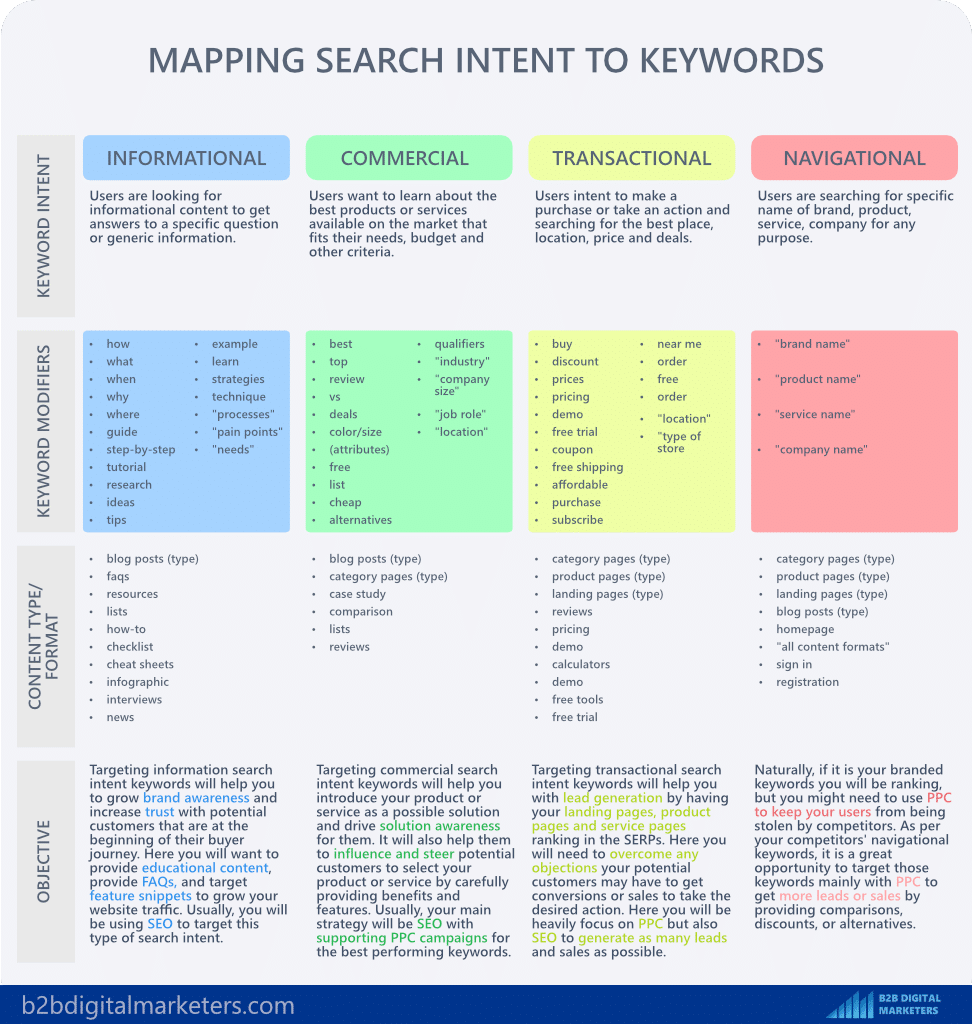
9. Optimize for Local SEO
The next best practice or strategy for construction for SEO is to optimize your website for Local SEO.
93% of users used online searches to find a local business to make a purchase of any kind. This applies to both B2C and B2B buyers.
And regardless you are an international or local business, your customers are searching for your services or products in local areas.
And Local SEO helps your business to promote your products or services to local customers in your target locations at the exact time they are looking for them.
For example, if you provide mini excavator rental services in a specific city, you want your business to show up when someone searches for “mini excavator rental in [city]” or “mini excavator rental services near me”.

Local SEO is important because it helps your business stand out in a crowded online marketplace. Local SEO is often easier to compete in, as you can focus your limited marketing resources on a specific geographic area, making it more effective.
With that being said, here are some of the most important Local SEO techniques and Local SEO best practices for construction businesses you should focus on:
- Create Google Business Profile: Many people in your area are searching on Google for your products or services and to give Google the right information to appear for these search results is by creating well-optimized and maintained GBP.
- Target local keywords: As shown, people will be searching for your products or services with local keywords, but you should also focus on creating location-specific educational content. For example “best home renovation tips in [city]” or “residential construction in [state]” could be some examples of local keywords you could target.
- Create location-based pages: To maximize your profitability and target the areas with the highest search demand for your products or services, you should create location pages with detailed information about your business’s location, including the address, phone number, and hours of operation and about the specific products or services you offer at that location, as well as any local promotions or events you are hosting.
- Register yourself for locally relevant directories: In addition to Google Business Profile, you should also register for local directories such as Yelp, Yellow Pages, and the Chamber of Commerce. This will help your business show up in local search results and give you an additional platform to interact with potential customers.
- Have consistent NAP: It is essential to have consistent and accurate NAP (name, address, and phone number) information on your website and across all online directories and platforms, as search engines use this information to verify the identity and location of your business. Inconsistent NAP information can confuse search engines and harm your local search rankings. I recommend following the exact format from your GBP.
- Actively collect reviews: As already said, reviews are essential for your business and you should actively collect them from your customers to improve your SEO results. In fact, 88% of consumers trust online reviews as much as personal recommendations.
Overall, Local SEO is crucial for your business as it can drive you the highest quality leads on autopilot in your target area and it is considerably easier to compete. Therefore, Local SEO should be your priority. To learn more you can also check out this article Local SEO for Doctors or SEO for landscaping as the principles are the same.
10. Build Strong Google Business Profile
According to WhiteSpark, Google Business Profile, previously known as Google My Business is the most important local search ranking factor that directly influences your ranking for local keywords.

Furthermore, the research also shows that Google is doubling down on its sources to provide relevant local search results.
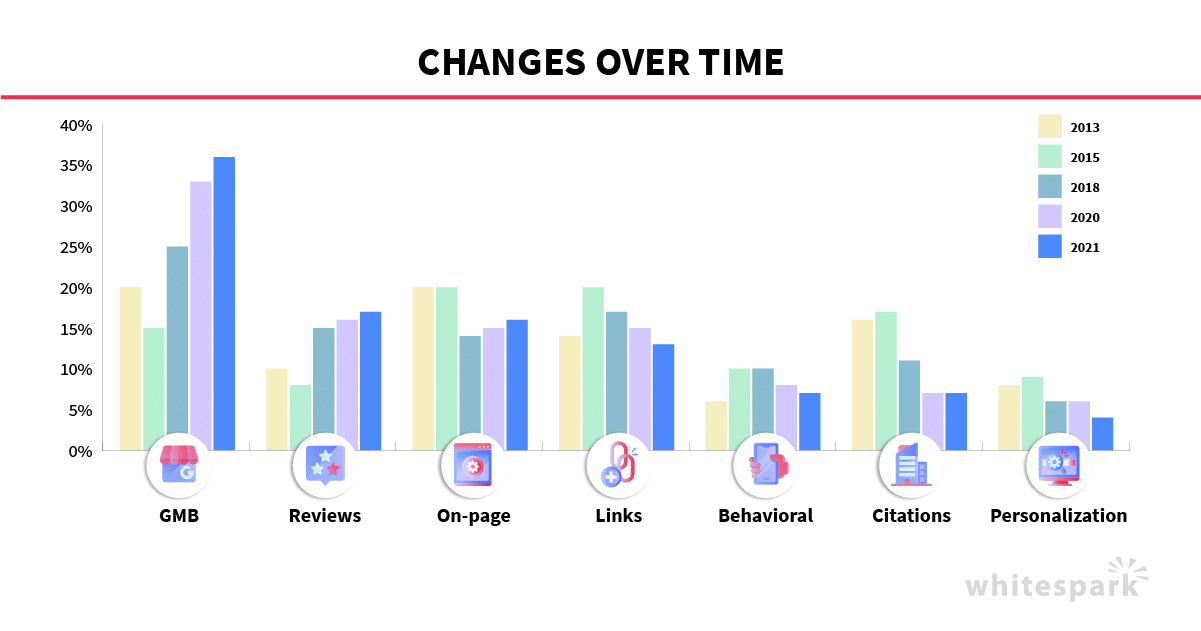
Therefore, well optimized Google Business Profile is just as important as a well-oiled crane. (You see what I did there, relevancy!)
With that being said, to make the most of your GBP profile, here are some best practices to follow:
- Claim your business: If your business has been around for a while, there’s a good chance that Google has already created a GBP profile for you. Make sure to claim it so that you can manage how your business is represented online.
- Add Correct Primary Category: Selecting the right primary category has a massive impact on your rankings. To make sure you’re getting the best results, pick a primary category that best describes your business. For example, if your business is a construction company, you would choose “Construction Company” as your primary category.
- Add Correct Additional Categories: This is another important aspect of optimizing your GBP. To make the most of this feature, make sure to include any additional categories that apply to your business. Each additional category is like an additional keyword that you can rank for, as long as your website provides relevant information and signals that support the category.
- Use important keywords: In your GBP description, categories, posts, reviews, and Q&A, be sure to include relevant keywords that describe your business. This will help Google to understand what your business does and where it is located, which can improve your search ranking.
- Post often: Posts are a great way to inform potential customers about your business and what you have to offer. Including pictures in your listing can also help to attract more attention, with businesses that include photos receiving 42% more requests for driving directions and 35% more click-throughs than those that don’t. (source)
- Collect reviews: It’s important to regularly collect reviews from your customers, as this can help to build trust and credibility with potential customers.
- Ensure 100% accuracy: Make sure to keep all of your business information accurate, as this will help customers to find you and make it more likely that they will choose your business over a competitor.
- Encourage people to post questions: Questions are a great way to boost your GBP listing and local SEO. Encourage customers to ask questions about your business, and be sure to promptly answer any questions that are asked.
- Set up messaging: GBP allows you to communicate with customers through messaging, which can be a convenient way for them to connect with your business and get quick answers to their questions.
- Add backlinks to your website: Linking to your website from your GBP profile can help Google to associate the two and make it easier for customers to find your website when they are searching for your business.
11. Find Important Local SEO Keywords
As I already said, customers are using local keywords to find your products or services.
In fact, the following statistics show how important is to optimize for local SEO keywords:
- 37% of searches for something to do result in a purchase (Google)
- 36% of searches for something to buy result in a purchase (Google)
- 18% of local searches for a product or service lead to a sale within one day (Google)
- 17% of searches for a product or service are followed by a phone call (BrightLocal)
And lastly, 46% of all Google searches are local which means there is a huge potential to target local areas.
So, in order to find local keywords, there are several methods to do.
Method #1: Search for Relevant Keywords with their location in them.
For example, you can search for a seed keyword such as “construction” in the keyword research tool and then add your target location into the “Word” filter to narrow down the search only to keywords with the location in it.

And this will give you the list of keywords with the keyword “construction” and the location.

Or you can simply use Google to find relevant keyword ideas.

Method #2: Analyze Your Competitors for local keywords.
As I already told you, doing competitor research to find keyword ideas can be a great way to expand your keyword list.
So, the same you can do for finding relevant local SEO keywords. Just find a local player and analyze their ranking keywords.

Method #3: Use your experience to answer any local questions.
The possible best keyword research is your own experience and answering any local common questions related to your industry.
I am not an expert in your industry and your local area obviously, so only I give you my example.
One of my clients is targeting the keywords ERP and CRM in location Malaysia and the common question they got is “what is the cost of ERP in Malaysia”.
So, they created a blog post with the main keyword “cost of ERP in Malaysia” and it does extremely well both in search demand and conversions as they could naturally include their product in it.
So, you want to do the same for your industry as well.
Method #4: Localize any relevant but general keywords you found.
For example, if you are targeting Florida in the US, then then you can localize the keyword “construction loan” to “construction loan florida” as this makes it more relevant for those searching in that area.
Here are some more examples:
| General Keyword | Localized Keyword |
|---|---|
| Home construction | Home construction in [city name] |
| Renovation services | Renovation services in [city name] |
| Remodeling costs | Remodeling costs in [city name] |
| Commercial construction | Commercial construction in [city name] |
| Home builders | Home builders in [city name] |
| General contractor | General contractor in [city name] |
| Home improvement ideas | Home improvement ideas in [city name] |
Note: You can replace [city name] with the specific city or area you want to target for better lead generation.
Final Advice for SEO for Construction
In conclusion, optimizing your construction website for SEO is an important step in driving more traffic to your site and ultimately growing your business.
Researching and targeting the right keywords, such as “construction”, “home builders”, “remodeling” and “home improvement” is essential for success.
By creating high-quality content that includes these primary keywords and building backlinks, you can help your site rise to the top of search engine results pages.
Additionally, it’s important to make sure that your site is mobile-friendly and has a strong on-page SEO, including meta tags and structured data.
Finally, you can also focus on local SEO strategy by including city or area-specific keywords, such as “home construction in [city name]”, “remodeling services in [city name]” and so on, to target potential customers in specific locations.
By following these tips and continuing to analyze your website’s performance, you can improve your search engine visibility and generate more leads for your construction business.
Related Articles:
Also, check out our SEO hub page to find all our SEO resources.
Disclaimer
Some of my links are affiliate links, which means if you purchase something, I might get a small commission as a reward for reference. Of course, I am actively using all these services and products, and I only affiliate products or services I have full trust in their quality!



